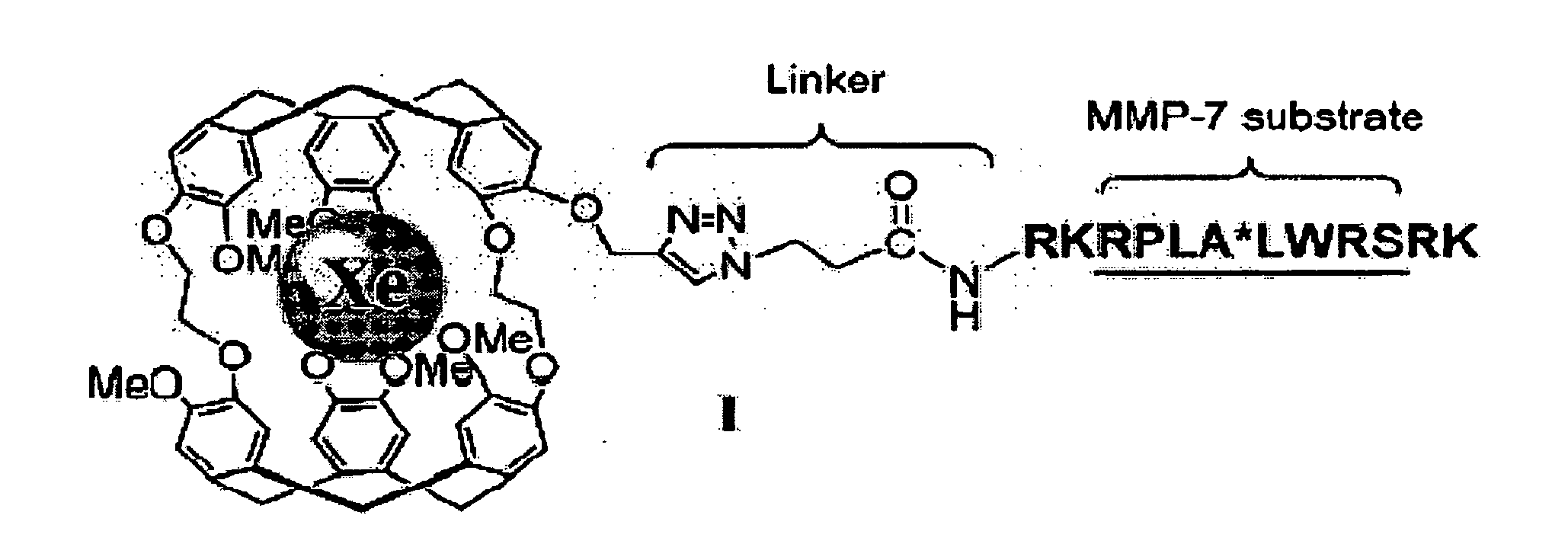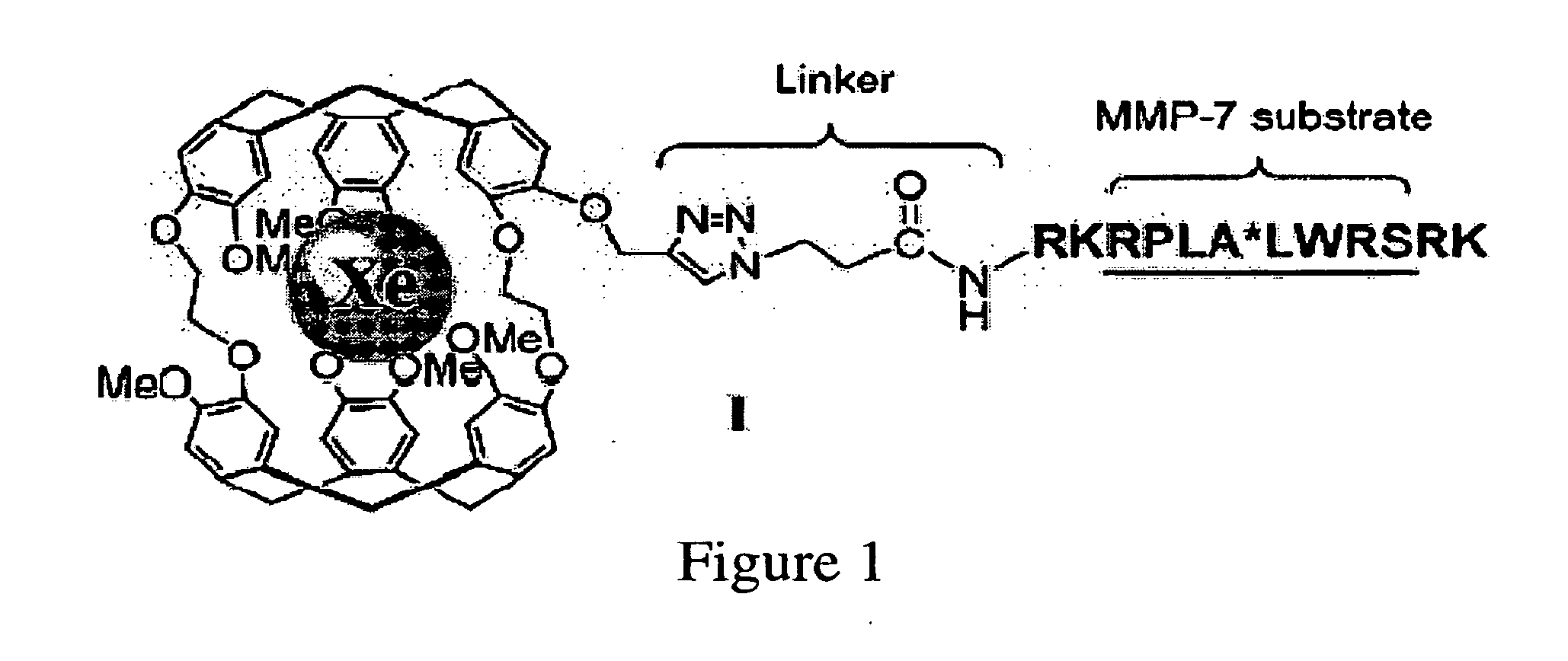129Xe BIOSENSORS AND THEIR USE
- Summary
- Abstract
- Description
- Claims
- Application Information
AI Technical Summary
Benefits of technology
Problems solved by technology
Method used
Image
Examples
example 1
Designing 129Xe NMR Biosensors for Matrix Metalloproteinase Detection
Synthesis of Peptide-Cryptophane-A Conjugates
[0120]In designing biosensor I, the sequence RPLALWRS was chosen because of the high specificity of MMP-7 for this substrate and its successful function in a fluorogenic beacon for in vivo detection and imaging of MMP-7. Schemes 1 and 2 outline the synthesis of I. Cryptophane-A was synthesized with a single propargyl group, which not only overcame the hurdles of allyl ether deprotection and subsequent low-yielding alkylation that confronted previous studies with cryptophanol, but also provided an efficient route to couple a variety of peptides to cryptophane-A via azide-alkyne [3+2] cycloaddition. II was generated through two different methods: a) MMP-7-mediated enzymatic hydrolysis of I, and b) direct synthesis on solid support, as described (Scheme 2—FIG. 5). Both routes gave the desired product, as confirmed by HPLC and MALDI-TOF mass spectrometry.
[0121]Monopropargyla...
example 2
Designing 129Xe NMR Biosensors with Improved Xe Incorporation
[0133]A facile synthesis for water-soluble cryptophane was developed and described above, based on the copper (I)-mediated [3+2] azide-alkyne Huisgen cycloaddition. The ten-step synthesis, shown above, yielded triacid-functionalized cryptophane (See FIG. 2) in 4% overall yield. Triacid-functionalized cryptophane (2 mM) was readily dissolved in aqueous base and remained soluble in 100 mM NaCl to pH ˜5.5. A solution of triacid-functionalized cryptophane (60 μM) in 1 mM, pH 7.2 phosphate buffer at 300 K had a hyperpolarized 129Xe NMR chemical shift of 64.6 ppm relative to xenon gas. 1H NMR measurements of triacid-functionalized cryptophane in D2O showed only the crown-crown structural isomer at temperatures as high as 333 K.
[0134]Triacid-functionalized cryptophane exhibited similar fluorescence in water (λem=313 nm) to the six 1,2-dialkoxybenzenes that form its cage. This led us to study the xenon binding equilibrium by heavy...
example 3
Designing 129Xe NMR Biosensors for Targeting αvβ3 Integrins
[0142]Studies have been conducted in the lab to assess the cell deliverability, toxicity, and targetability of Xe biosensors.
[0143]Many cancer cells are known to present on their surfaces higher than normal levels of integrins. Cyclic RGD peptides, as well as RGD repeats (i.e., tetraRGD: RGDRGDRGDRGD) are known to bind some integrins with very high affinity, and get taken up into cells. Thus, the attachment of tetraRGD to a cryptophane was expected to produce preferential uptake by some cancer cells relative to healthy cells (i.e., red blood cells) that do not express integrins on their surface.
[0144]129Xe biosensor was synthesized for targeting αvβ3 integrin, which is over-expressed on the surface of many pancreatic cancer cells and is shown in FIG. 23.
[0145]In addition, the biosensor was labeled with Cy3, an NIR dye. The scheme for labeling the cryptophane biosensor containing the tetra-RGD peptide (RGDRGDRGDRGD, SEQ ID. N...
PUM
| Property | Measurement | Unit |
|---|---|---|
| Fluorescence | aaaaa | aaaaa |
| Chemical shift | aaaaa | aaaaa |
Abstract
Description
Claims
Application Information
 Login to View More
Login to View More - R&D
- Intellectual Property
- Life Sciences
- Materials
- Tech Scout
- Unparalleled Data Quality
- Higher Quality Content
- 60% Fewer Hallucinations
Browse by: Latest US Patents, China's latest patents, Technical Efficacy Thesaurus, Application Domain, Technology Topic, Popular Technical Reports.
© 2025 PatSnap. All rights reserved.Legal|Privacy policy|Modern Slavery Act Transparency Statement|Sitemap|About US| Contact US: help@patsnap.com



